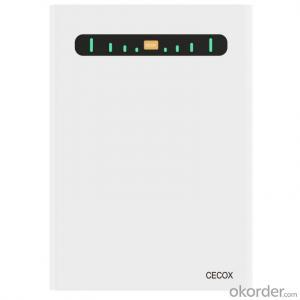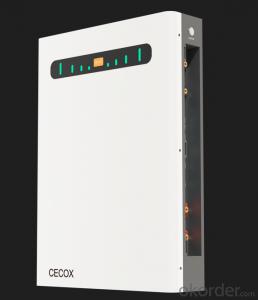Lithium Battery Wall Mounted Support for up to 16 batteries in parallel 41-55V NCQ
- Loading Port:
- SHANGHAI
- Payment Terms:
- TT OR LC
- Min Order Qty:
- 10 unit
- Supply Capability:
- 100 unit/month
OKorder Service Pledge
OKorder Financial Service
You Might Also Like
Parameters | ||
Product Model | Watt 1-s | Watt 1 |
Nominal Energy | 2.5KWH | 5KWH |
Nominal Voltage | 25.6V | 51.2V |
Nominal Capacity | 100Ah | 100Ah |
Cell Type | LFP | LFP |
Standard Charge Voltage | 29.2V | 58.4V |
Max Charge Current | 100A | 100A |
Discharge Cut-Off Voltage | 20v | 40V |
Max Discharge Current | 100A | 100A |
Parallel Function | Support parallel | Support 15 Units in Parallel |
Communication Interface | No Communication | RS485、RS232、CAN(Optional) |
Calendar Life | 15+Years @25C 80%DOD | |
Cycle Life | ≥6000 Cycles (80%DOD) | |
Charge temperature range | 0~65℃ | |
Discharge temperature range | -20~65℃ | |
Certification | Cell: UL1642/IEC62619/CE/ROHS/ MSDS/UN38.3 Pack: MSDS/UN38.3 | |
Dimensions | 430*600*105mm | 570*690*105mm |
Weight | 28Kg | 46Kg |
Source with confidence
√ Direct from Verified Custom Manufacturer
Application:
Household,Hospital, Bank, Airport, Power plant and other systems.
Solar energy storage cabinet
Long last UPS battery.
Phone switch, Telecom room SMR hospitals.

ADVANTAGES
About 2000-6000 cycles, up to 10 times longer life span compared to lead-acid batteries.
More Usable Capacity
100% depth of discharge (DOD),25-50% more usable capacity than lead-acid batteries.
Lightweight
Average 70% lighter than the same size traditional lead-acid batteries.
Fast &Safe Charge
High charge/discharge rate, charge much faster than traditional lead-acid batteries.
Built-in Protection
Every battery comes with a built-in battery protection system.
Drop-in Replacement
A variety of BCI standard sizes or custom solution for easy drop-in replacement.
Eco-friendly
Ultimate clean energy, no gassing, no fumes, no pollution, on-hazardous batteries.



Order!Order!Order!
CONVENIENT AND BEAUTIFUL ENERGY STORAGE DEVICE, TO ENSURE THAT YOU CAN GET THE LIGHT AT ANY TIME AND PLACE. TO ORDER IT, QUALITY SERVICE, REASONABLE PRICE AND PERFECT AFTER-SALES.
FAQ:
Who are we?
We are based in Beijing, China, start from 2004,sell to all countries. There are more than300 people in our office.
How can we guarantee quality?
Always a pre-production sample before mass production;
Always final Inspection before shipment;
What can you buy from us?
Energy Storage System,Power Storage Battery,Solar Panels,Energy Etorage Battery,LiFePO4 Battery Storage System
Why should you buy from us not from other suppliers?
Focus on the R&D, production and sales of power batteries & energy storage system.
What services can we provide?
Accepted Delivery Terms: FOB,CFR,CIF,EXW,DDU,Express Delivery;
Accepted Payment Currency:USD,CNY;
Can I have a sample order?
Yes, we welcome sample order to test and check quality.
Would you accept to use our logo ?
All of our products are accepted to print your logo on the enclosure and package box,it depends on the amount, from 200pcs to1000pcs.
What kind of certificate you have ?
CE/TUV/MSDS/ISO/CB/UL/ROHS certificates.etc.
How to choose suitable inverter?
If your load is resistive loads, such as: bulbs, you can choose a modified wave inverter. But if it is inductive loads and capacities loads,we recommend using pure sine wave power inverter.
How do I choose the size of the inverter?
Different types of load demand for power are different. You can view the load power values to determine the size of the power inverter.
- Q: I have a nyko charging station for my xbox 360 controllers but they wont hold a charge anymore. I put them on the dock station and it says they are charged after like 15 mins but then they dont last very long. Wasnt sure if it would be the battery packs or the dock station.
- I would say it's the battery packs. They don't usually last much longer than a year or so.
- Q: I want to buy an external battery pack for my iPhone 4 and I see that there are many different levels to choose from. I see packs with 1000mAh, 1800mAh, 1900mAh and so on up to 5000+mAh. My question is what difference does the mAh make in a battery pack? Is it the amount of charge it gives the phone? Is it the length of time it takes to charge? I want to be more educated before I make a purchase.
- NG okorder
- Q: I bought rechargeable batteries for my Nikon but I don't want to rely on those to last the whole time I'm gone. The rechargeable ones WILL already be in my Nikon. But how do I pack extra AA batteries? I have the Kirkland brand ones that AREN'T individually packed.
- I wouldn't worry about it. I always bring my camera with an extra battery or two in the camera case that stay in my backpack. No one has ever questioned it. I even have a spare AAA battery floating around the same backpack, again never questioned. I fly about 3 times a month domestically and I think it would have come up by now if it were an issue. I also brought extras for my Motorola Razor, when I still had it and same story.
- Q: I have an old remote control air plane rechargeable battery I want to use for something else. The problem is I need it 9.6V and the two packs of 5 cells is 6V each. I want to combine the two 6V into an 8 cell 9.6V but I can't seem to split them apart. Currently I'm discharging them through the old airplane motor that they came with. First off, should I be messing with them. If so, is running them through a motor a good way to discharge them, and finally how should I go about separating them so I can recombine them?
- Those 6V battery pack was packed with hard glue and welded joints. Separating them is not an easy task as you though without any proper tool. Besides, most old old rechargeable battery pack 50% inside the cells were dried out or leakage or shorted due to aging. Not much chance to rebuild them into a workable 9.6V pack.
- Q: i have the old note 10.1 (not the 2014 edition). i was wondering if anyone knows of a good battery pack/portable battery/external charger for the note 10.1. i read that some battery packs only charged the tablet while it was off, and i need a battery pack that will charge my tablet while it is on and i am using the device
- RavPower okorder
- Q: I put the play and charge pack in and my controller keeps blinking and the dashboard button the one that blinks doesnt work or neither does any other button
- that means you need to recharge the battery pack because it also does that when you need to replace the batteries.
- Q: I need camera bag for my canon 7D with battery pack and canon 24-70 attached with hood reversed with Mac Air or Ipad 4. Slingshot preferred, but defiantly not Kata 3 in 33 size (already have that looking for something smaller). I will only carry 7D with body grip 24-70 and flash and ipad 4, maybe my 10-22 or 18-200 if it has more space. Of course my battery charger, memory cards, readers and cleaning kit. Thnx in advance
- You do not / cannot. The battery wishes to be eliminated and recharged in a charger. Leaving your digital camera on outside in a single day is the the fine of recommendations. And the outcome aren't going to be excellent.
- Q: i bought the limited edition red controller that came with the play and charge kit thing mid to late last year. recently my 360 red ringed :( but i got it back a few weeks ago, but since i couldn't play it my battery pack just died inside of it (i thnk i only had 2 cells left in it). but i have been playing with it plugged in to the 360 like i did when i would charge it. everything else works fine, but i don't know if maybe a few months from now if i should buy a new battery pack, switch to using real batteries, or just keep doing what i've been doing for the last couple of weeks.
- Been doing the same thing for over two years now and hasn't affected the controller Take the battery pack out when not in use otherwise it will leak and corrode the terminals
- Q: I have a 12v monitor and a 12v spy camera could I hook them up to a 12v battery pack with a dc splitter, or would there be issues. But I also have a 8v spy camera, is there a easy way to hook it up to a 9v battery?
- You need a 12 v pack with enough current to operate them both for some period of time. So you need to know how much current they use in a given hour. They should spec their power usage in watts. So you divide that by 12. That will give you their current draw for one hour. Then, if you want them to operate, say for 8 hours, you need a battery pack with an output of a little more than their total current drain over that time. Say they draw 1 watt each, so that is 16 watts over 8 hours. 16 w/12 v is 1.33 amp/hours. So, in this case, you would want a battery pack capable of at least 1.5 amp/hours. The 8 volt unit is much the same. You need to know it's current drain per hour and then you need a 9 v battery with a high enough amp/hour output to run it for how long it will be on. A simple small 9 v battery won't have enough power to even turn it on, much less, run it for any time at all. You would be better off to use the 12 v supply (if big enough) to run all 3 and just use a current limiting resistor in the 8 v line.
- Q: I have a pre lit door wreath and no good way to plug it in. I was hoping i could find a small little battery pack to plug a regular plug into. Does that exist? I can't seem to find anything online.
- You could try re-wiring it to connect it with a battery pack, something that's not too heavy so u could hide it in the wreath. That mite be an option. Or check at Home Depot, maybe they may have what your looking for.
Send your message to us
Lithium Battery Wall Mounted Support for up to 16 batteries in parallel 41-55V NCQ
- Loading Port:
- SHANGHAI
- Payment Terms:
- TT OR LC
- Min Order Qty:
- 10 unit
- Supply Capability:
- 100 unit/month
OKorder Service Pledge
OKorder Financial Service
Similar products
Hot products
Hot Searches





























